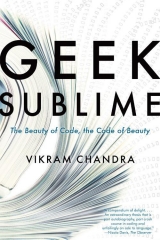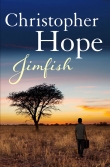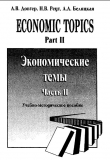
Текст книги "Geek Sublime: The Beauty of Code, the Code of Beauty"
Автор книги: Vikram Chandra
Жанры:
Современная проза
,сообщить о нарушении
Текущая страница: 14 (всего у книги 15 страниц)
Khan, Taslima. “40 % of Startups in Silicon Valley Are Headed by India-Based Entrepreneurs.” Business Today, March 21, 2013. http://businesstoday.intoday.in/story/google-executive-chairman-eric-schmidt-on-india/1/193496.html.
Kiparsky, Paul. “On the Architecture of Pāṇini’s Grammar.” In Sanskrit Computational Linguistics, 33–94. Springer, 2009. http://link.springer.com/chapter/10.1007/978-3-642-00155-0_2.
______. “Paninian Linguistics.” The Encyclopedia of Language and Linguistics6 (1995): 59–65.
Knuth, Donald E. “All Questions Answered.” Notices of the AMS49, no. 3 (2002): 318–24.
______. “Literate Programming.” The Computer Journal27, no. 2 (January 1, 1984): 97–111. doi:10.1093/comjnl/27.2.97.
Kotler, Steven. “Synthetic Biology for Dummies, Investors or Both …” Forbes.com, November 8, 2012. http://www.forbes.com/sites/stevenkotler/2012/11/08/synthetic-biology-for-dummies-investors-or-both/.
Kwak, James. “The Importance of Excel.” The Baseline Scenario (blog), February 9, 2013. http://baselinescenario.com/2013/02/09/the-importance-of-excel/#.
Lacy, Sarah. “And You Thought SF Cabs Were Bad? BART Strike Is Crippling Fledgling Mid-market Tech Corridor.” PandoDaily (blog), July 2, 2013. http://pandodaily.com/2013/07/02/and-you-thought-sf-cabs-were-bad-bart-strike-is-crippling-fledgling-mid-market-tech-corridor/.
Lampson, Butler W. “Guest Editorial.” Software: Practice and Experience2, no. 3 (1972): 195–196.
Lanier, Jaron. “The Suburb That Changed the World.” New Statesman, August 18, 2011. http://www.newstatesman.com/scitech/2011/08/silicon-valley-computer.
Leeds, Barry H. The Enduring Vision of Norman Mailer.Bainbridge, WA: Pleasure Boat Studio, 2002.
Leeming, David. The Oxford Companion to World Mythology.New York: Oxford University Press, 2005.
Leonard, Andrew. “Let My Software Go!” Salon.com, March 30, 1998. http://www.salon.com/1998/03/30/feature947788266/.
Lippert, Eric. “Cargo Cultists, Part Three: Is Mort a Cargo Cultist?” Eric Lippert’s Blog: Fabulous Adventures in Coding, March 2, 2004. http://blogs.msdn.com/b/ericlippert/archive/2004/03/02/cargo-cultists-part-three-is-mort-a-cargo-cultist.aspx.
Livingston, Jessica. Founders at Work: Stories of Startups’ Early Days.Berkeley: Apress, 2008.
MacMillan, Douglas. “The Rise of the ‘Brogrammer.’” Businessweek, March 1, 2012. http://www.businessweek.com/articles/2012-03-01/the-rise-of-the-brogrammer.
Manjali, Franson. “The ‘Social’ and the ‘Cognitive’ in Language: A Reading of Saussure, and Beyond.” Hal.archives-ouvertes.fr/, 2012. http://hal.archivesouvertes.fr/halshs-00724036/.
Masson, Jeffrey Moussaieff, and M. V. Patwardhan. Aesthetic Rapture: The Rasādhyāya of the Nāṭyásāstra.Poona: Deccan College, Postgraduate and Research Institute, 1970.
Mataes, M., and N. Montford. “A Box, Darkly: Obfuscation, Weird Languages, and Code Aesthetics.” In Proceedings of the 6th Digital Arts and Culture Conference, IT University of Copenhagen(2005): 144–53.
Matilal, Bimal Krishna. “Vakroti and Dhvani: Controversies about the Theory of Poetry in the Indian Tradition.” In Abhinavagupta: Reconsiderations, edited by Makarand Paranjape and Sunthar Visuvalingam, 372–81. New Delhi: Samvad, 2012.
Matsumoto, Yukihiro. “Treating Code as an Essay.” In Beautiful Code: Leading Programmers Explain How They Think, edited by Andy Oram and Greg Wilson, loc. 13832–6127. Sebastopol, CA: O’Reilly Media, 2007. Kindle edition.
Matthews, Peter Hugoe. The Concise Oxford Dictionary of Linguistics.2nd ed. Oxford: Oxford University Press, 2007.
Matyszczyk, Chris. “Woz: Microsoft Might Be More Creative Than Apple.” Technically Incorrect – CNET News, November 15, 2012. http://news.cnet.com/8301-17852_3-57550839-71/woz-microsoft-might-be-more-creative-than-apple/.
McCrea, Lawrence J. The Teleology of Poetics in Medieval Kashmir.Cambridge, MA: Harvard University, Department of Sanskrit and Indian Studies, 2008.
McPherson, Amanda, Brian Proffitt, and Ron Hale-Evans. “Estimating the Total Development Cost of a Linux Distribution.” Linuxfoundation.org, September 2008. http://www.linuxfoundation.org/sites/main/files/publications/estimatinglinux.html.
Merwin, William Stanley. East Window: The Asian Translations.Port Townsend: Copper Canyon Press, 1998.
“Most Widely Deployed SQL Database Engine.” Sqlite.org. Accessed February 3, 2013. http://www.sqlite.org/mostdeployed.html.
Mukherji, Anahita. “Student Suicides Soar 26 % in 5 Years, Education System Blamed.” Times of India, November 2, 2011. http://articles.timesofindia.indiatimes.com/2011-11-02/india/30349474_1_student-suicides-education-system-higher-education.
Muller-Ortega, Paul Eduardo. “Seal of Sambhu.” In Tantra in Practice, edited by David Gordon White. Princeton: Princeton University Press, 2000.
_______. The Triadic Heart of Śiva: Kaula Tantricism of Abhinavagupta in the Non-dual Shaivism of Kashmir.New York: State University of New York Press, 1988.
Nather, Ed. “The Story of Mel.” May 21, 1983. http://www.cs.utah.edu/%7Eelb/folklore/mel.html.
O’Connor, Flannery. Mystery and Manners: Occasional Prose.Edited by Sally Fitzgerald and Robert Fitzgerald. New York: Farrar, Straus and Giroux, 1970.
Oliver, Jonathan. “Why I Still Love CQRS (and Messaging and Event Sourcing).” Jonathan Oliver (blog), May 9, 2011. http://blog.jonathanoliver.com/2011/05/why-i-still-love-cqrs-and-messaging-and-event-sourcing/.
Oram, Andy, and Greg Wilson, eds. Beautiful Code: Leading Programmers Explain How They Think.Sebastopol, CA: O’Reilly Media, 2007. Kindle edition.
Paltrow, Scot J., and Kelly Carr. “How the Pentagon’s Payroll Quagmire Traps America’s Soldiers.” Reuters, July 9, 2013. http://www.reuters.com/article/2013/07/09/us-usa-pentagon-payerrors-special-report-idUSBRE96818I20130709.
Pandit, Lalita. “Dhvani and the ‘Full Word’: Suggestion and Signification from Abhinavagupta to Jacques Lacan.” College Literature23, no. 1 (1996): 142–63.
Panini. Ashtadhyayi.Vedic Literature Collection. Fairfield, IA: Maharishi University of Management, n.d.
Parashar, Sadhana, and Rājaśekhara. Kāvyamīmāṃsā of Rājaśekhara: Original Text in Sanskrit and Translation with Explanatory Notes.New Delhi: D.K. Printworld, 2000.
The Paris Review. The Paris Review Interviews, III. New York: Picador, 2008.
Petzold, Charles. Code: The Hidden Language of Computer Hardware and Software.N.p.: Microsoft Press, 2009.
Pipher, Mary. Writing to Change the World.New York: Riverhead Trade, 2007.
Pollock, Sheldon. “The Cosmopolitan Vernacular.” The Journal of Asian Studies57, no. 1 (February 1998): 6–37. doi:10.2307/2659022.
______. “The Death of Sanskrit.” Comparative Studies in Society and History43, no. 2 (2001): 392–426.
_______. The Language of the Gods in the World of Men: Sanskrit, Culture, and Power in Premodern India.Berkeley: University of California Press, 2006.
______. “What Was Bhaṭṭa Nāyaka Saying? The Hermeneutical Transformation of Indian Aesthetics.” Epic and Argument in Sanskrit Literary History.New Delhi: Manohar, 2010.
Pomeda, Carlos Gómez. The Heart of Recognition: A Translation and Study of Kṣemarāja’s Pratyabhijñāhṛdayam.Berkeley: University of California, 2001.
“Programming the ENIAC.” Columbia University Computing History: A Chronology of Computing at Columbia University.Last updated April 2, 2012. http://www.columbia.edu/cu/computinghistory/index.html.
Purushothaman, Ranjith, and Dewayne E. Perry. “Toward Understanding the Rhetoric of Small Source Code Changes.” IEEE Transactions on Software Engineering31, no. 6 (2005): 511–26.
Raj, Ritu. “Indian Mafia.” Medium (blog), February 17, 2013. https://medium.com/behind-the-scene-silicon-valley/7051c3f5e37c.
Ramanujan, A. K., trans. The Interior Landscape: Love Poems from a Classical Tamil Anthology.New York: Oxford University Press, 1994.
Ramaswamy, Sumathi. “Sanskrit for the Nation.” Modern Asian Studies33, no. 2 (1999): 339–81.
Ratié, Isabelle. “Otherness in the Pratyabhijñā Philosophy.” Journal of Indian Philosophy35, no. 4 (September 2, 2007): 313–70. doi:10.1007/s10781-007-9017-5.
______. “Remarks on Compassion and Altruism in the Pratyabhijñā Philosophy.” Journal of Indian Philosophy37, no. 4 (February 14, 2009): 349–66. doi:10.1007/s10781-009-9066-z.
Raymond, Eric S. “Microsoft Tries to Recruit Me.” Armed and Dangerous (blog), September 8, 2005. http://esr.ibiblio.org/?p=208.
Rob P. “How Do Computers Work?” Programmers.stackoverflow.com, June 5, 2011. http://programmers.stackexchange.com/questions/81624/how-do-computers-work.
Rosenberg, Scott. Dreaming in Code: Two Dozen Programmers, Three Years, 4,732 Bugs, and One Quest for Transcendent Software.New York: Three Rivers Press, 2008.
Rotter, Andrew J. “Gender Relations, Foreign Relations: The United States and South Asia, 1947–1964.” The Journal of American History81, no. 2 (1994): 518–42.
Sanderson, Alexis. “Purity and Power among the Brahmans of Kashmir.” The Category of the Person: Anthropology, Philosophy, History(1985): 190–216.
______. “Śaivism and the Tantric Traditions.” The World’s Religions(1988): 660–704.
Saxena, Vinay, Parul Saxena, and Kuldeep Pandey. “Panini’s Grammar in Computer Science.” Recent Research in Science and Technology3, no. 7 (2011): 109–11.
Savoia, Alberto. “Beautiful Tests.” In Beautiful Code: Leading Programmers Explain How They Think, edited by Andy Oram and Greg Wilson, loc. 2958–3491. Sebastopol, CA: O’Reilly Media, 2007. Kindle edition.
Scheffer, Lou. “Programming in Malbolge.” Accessed June 11, 2013. http://www.lscheffer.com/malbolge.shtml.
Schelling, Andrew. The Cane Groves of Narmada River: Erotic Poems from Old India.San Francisco: City Lights Books, 1998.
Schlesinger, Jill. “JPMorgan Chase Earnings: ‘London Whale’ Cost $5.8 Billion.” CBS Money Watch, July 13, 2012. http://www.cbsnews.com/8301-505123_162-57471697/jpmorgan-chase-earnings-london-whale-cost-$5.8-billion/.
Scott, Alec. “Lessons from Canada’s Silicon Valley Diaspora.” The Globe and Mail, February 23, 2012. http://www.theglobeandmail.com/report-on-business/rob-magazine/lessons-from-canadas-silicon-valley-diaspora/article535544/?service=print.
Shulman, David. “The Buzz of God and the Click of Delight.” In Aesthetics in Performance: Formations of Symbolic Construction and Experience, edited by Angela Hobart and Bruce Kapferer, 43–63. New York: Berghahn Books, 2005.
Silver, Nate. “In Silicon Valley, Technology Talent Gap Threatens G.O.P. Campaigns.” New York Times, November 28, 2012.
“Similarities between Sanskrit and Programming Languages.” uttiSTha bhArata. Accessed August 16, 2013. http://uttishthabharata.wordpress.com/2011/05/30/sanskrit-programming/.
Simon, Reeva Spector. Spies and Holy Wars: The Middle East in 20th-Century Crime Fiction.Austin, TX: University of Texas Press, 2011.
Singh, Sanjay. “New Life, Old Death for Sanskrit in Uttarakhand.” Indian Express, June 29, 2013. Mobile edition. http://m.indianexpress.com/news/new-life-old-death-for-sanskrit-in-uttarakhand/1126773/.
Sivakumar, N. Dude, Did I Steal Your Job? Debugging Indian Computer Programmers.Bridgewater: Divine Tree, 2004.
Skora, Kerry Martin. “Abhinavagupta’s Erotic Mysticism: The Reconciliation of Spirit and Flesh.” International Journal of Hindu Studies11, no. 1 (2007): 63–88.
______. “The Pulsating Heart and Its Divine Sense Energies: Body and Touch in Abhinavagupta’s Trika Śaivism.” Numen54, no. 4 (October 1, 2007): 420–58. doi:10.1163/156852707X244298.
Solnit, Rebecca. “Diary.” London Review of Books.Accessed February 7, 2013. http://www.lrb.co.uk/v35/n16/rebecca-solnit/diary.
Spectre, Rob. “Twilio’s Definitive Brogramming Primer.” YouTube video, 14:34. Twilio Conference, uploaded September 22, 2011. http://www.youtube.com/watch?v=Qi_AAqi0RZM.
Srinivas, M. D. “Amarabh&abarratī: Sanskrit and the Resurgence of Indian Civilization.” In Indian Knowledge Systems, vol. 1, 33–48. Shimla: Indian Institute of Advanced Study, 2005.
Staal, J. F. “Context-Sensitive Rules in Pān․ini.” Foundations of Language1, no. 1 (1965): 63–72.
Stahl, Leslie. “Imported from India.” 60 Minutes. CBS Video. June 22, 2003.
Subbanna, Sridhar, and Srinivasa Varakhedi. “Computational Structure of the Aṣṭādhyāyīand Conflict Resolution Techniques.” In Sanskrit Computational Linguistics, 56–65. Springer, 2009.
Swain, F. “Glowing Trees Could Light up City Streets.” New Scientist208, no. 2788 (2010): 21.
Swan, Rachel. “Outside the Gates: Unions Versus Big Tech.” SF Weekly, July 3, 2013. http://www.sfweekly.com/2013-07-03/news/apple-google-seiu-sis-manny-cardenas/full/.
“Team: Heidelberg LSL.” Igem.org. Accessed February 3, 2013. http://2012hs.igem.org/Team: Heidelberg_LSL.
Tedd, Eugene. “Hours of Hell and Anguish.” Prairie Schooner(1955): 95–108.
Tharu, Susie, and K. Lalita, eds. Women Writing in India: 600 B.C. to the Present.New York: The Feminist Press at CUNY, 1993.
“The International Obfuscated C Code Contest.” Iocc.org. Accessed February 3, 2013. http://www.ioccc.org/.
Toole, Betty Alexandra. Ada, the Enchantress of Numbers: Poetical Science.Sausalito: Critical Connection, 2010. Kindle Edition.
Torvalds, Linus. “Re: Stable Linux 2.6.25.10.” Gmane.org, July 15, 2008. http://article.gmane.org/gmane.linux.kernel/706950.
Turing, Alan. “On Computable Numbers, with an Application to the Entscheidungs-problem (1936).” In The Annotated Turing: A Guided Tour through Alan Turing’s Historic Paper on Computability and the Turing Machine, by Charles Petzold. Indianapolis: Wiley, 2008.
Urban, Hugh B. The Economics of Ecstasy: Tantra, Secrecy, and Power in Colonial Bengal.New York: Oxford University Press, 2001.
______. The Power of Tantra: Religion, Sexuality and the Politics of South Asian Studies.London: IB Tauris, 2009. Kindle edition.
Varma, Roli. “Computing Self-Efficacy among Women in India.” Journal of Women and Minorities in Science and Engineering16, no. 3 (2010): 257–74.
______. “Exposure, Training, and Environment: Women’s Participation in Computing Education in the United States and India.” Journal of Women and Minorities in Science and Engineering15, no. 3 (2009): 205–22.
Wadhwa, Vivek. “The Face of Success, Part I: How the Indians Conquered Silicon Valley.” Inc.com, January 13, 2012. http://www.inc.com/vivek-wadhwa/how-the-indians-succeeded-in-silicon-valley.html.
Wallis, Christopher. “The Descent of Power: Possession, Mysticism, and Initiation in the Śaiva Theology of Abhinavagupta.” Journal of Indian Philosophy36, no. 2 (2008): 247–95.
Warner, Melanie. “The Indians of Silicon Valley.” Money.cnn.com, May 15, 2000. http://money.cnn.com/magazines/fortune/fortune_archive/2000/05/15/279748/.
West, James L. III, ed. Conversations with William Styron.Limited ed. Jackson: University Press of Mississippi, 1985.
Wezler, Albrecht. “Do You Speak Sanskrit? On a Class of Sanskrit Texts Composed in the Late Middle Ages.” Ideology and Status of Sanskrit: Contributions to the History of the Sanskrit Language, edited by Jan E. M. Houben, 327–46. Leiden: Brill, 1996.
“Whatever Happened to Programming?” News.ycombinator.com, March 3, 2010. http://news.ycombinator.com/item?id=1165623.
White, David Gordon. “Introduction: Tantra in Practice: Mapping a Tradition.” In Tantra in Practice.Princeton: Princeton University Press, 2000.
“Why Sanskrit Is Best Language for Computer?” Yahoo! Answers. Accessed August 16, 2013. http://in.answers.yahoo.com/question/index?qid=20061108053328AAzdnNE.
Winegrad, Dilys, and Atsushi Akera. “A Short History of the Second American Revolution.” University of Pennsylvania Almanac42, no. 18 (1996): 4–7.
Witzel, Michael. “On the Origin of the Literary Device of the Frame Story in Old Indian Literature.” In Hinduismus Und Buddhismus: Festschrift Für Ulrich Schneider, edited by Harry Falk, 380–414. Freiburg: Hedwig Falk, 1987.
World Economic Forum. Global Gender Gap Report.October 23, 2012. http://www.weforum.org/issues/global-gender-gap.
Wozniak, Steve. “And Then There Was Apple.” Apple II History. Accessed August 10, 2013. http://apple2history.org/museum/articles/ca8610/.
Wright, Edmund, and John Daintith. A Dictionary of Computing.Online. Oxford University Press, 2008. http://www.oxfordreference.com/10.1093/acref/9780199234004.001.0001/acref-9780199234004-e-2050.
Wujastyk, Dominik. “Indian Manuscripts.” In Manuscript Cultures: Mapping the Field, edited by Jörg Quenzer and Jan-Ulrich Sobisch. Berlin: Walter De Gruyter Inc., 2013.
Yegge, Steve. Foreword to The Joy of Clojure: Thinking the Clojure Way, XVII–XVI. Stamford, CT: Manning Publications, 2011.
Zihotki. “Raven & Event Sourcing.” Ayende@Rahien. Accessed August 17, 2013. http://ayende.com/blog/4530/raven-event-sourcing.
COPYRIGHT ACKNOWLEDGMENTS
Grateful acknowledgment is made to the following for permission to reprint copyright material:
Prose
1. The Wiley Press for extracts from “Guest Editorial” by Butler W. Lampson from Software: Practice and Experience2, no. 3 (1972): 195–96.
2. Maciej Ceglowski for extracts from “Dabblers and Blowhards” from Idle Words (blog), April 4, 2006. Text available at http://www.idlewords.com/2005/04/dabblers_and_blowhards.htm.
3. David Barrett for extracts from “Why We Don’t Hire.NET Programmers” from Expensify (blog), March 25, 2011. Text available at http://blog.expensify.com/2011/03/25/ceo-friday-why-we-dont-hire-net-programmers/.
4. Derick Bailey for extracts from “Dear Open Source Project Leader: Quit Being a Jerk” from LosTechies.com December 14, 2012. Text available at http://lostechies.com/derickbailey/2012/12/14/dear-open-source-project-leader-quit-being-a-jerk/.
5. Vivek Wadhwa for extracts from “The Face of Success, Part I: How the Indians Conquered Silicon Valley” from Inc.com, last updated on January 13, 2012. Text available at http://www.inc.com/vivek-wadhwa/how-the-indians-succeeded-in-silicon-valley.html.
6. Roli Varma for extracts from “Exposure, Training, and Environment: Women’s Participation in Computing Education in the United States and India” from the Journal of Women and Minorities in Science and Engineering15, no. 3 (2009): 205–22.
7. James Kwak for extracts from “The Importance of Excel” from The Baseline Scenario (blog), February 9, 2013. Text available at http://baselinescenario.com/2013/02/09/the-importance-of-excel/#.
8. Joshua Bloch for extracts from “Extra, Extra – Read All About It: Nearly All Binary Searches and Mergesorts Are Broken” from Google Research Blog, June 2, 2006. Text available at http://googleresearch.blogspot.com/2006/06/extra-extra-read-all-about-it-nearly.html.
9. P. N. Furbank, copyright © P. N. Furbank, for permission to reprint two postcards (page 229) written by Alan Turing to Robin Gandy, from the series “Messages from the Unseen World,” The Turing Digital Archive, King’s College, University of Cambridge. Postcards available at http://www.turingarchive.org/viewer/?id=154&title=14 and http://www.turingarchive.org/viewer/?id=154&title=16.
Poetry
1. Oxford University Press for “What could my mother be to yours?” by Cempulappeyanirar, translated by A. K. Ramanujan in The Interior Landscape: Love Poems from a Classical Tamil Anthology, Oxford University Press, 1994.
2. Susie Tharu and K. Lalita for “A woman well set free!” by Sumangalamata and “If I ask her not to get too close” by Muddupalani, translated by Susie Tharu and K. Lalita in Women Writing in India: Love Poems from a Classical Tamil Anthology, The Feminist Press at CUNY, 1993.
3. City Lights Press, copyright © 1998 by Andrew Schelling, for “Black swollen clouds” and “To Her Daughter” by Vidya, and “Nights of jasmine & thunder” by Shilabhattarika, translated by Andrew Schelling in The Cane Groves of Narmada River: Erotic Poems from Old India, City Lights Books, 1998.
4. The Wylie Agency for “A poet should learn with his eyes” by Kshemendra, translated by William Stanley Merwin and Jeffery Moussaieff Masson in East Window: The Asian Translations, Copper Canyon Press, 1998.
5. Columbia University Press for “I don’t know mantra from tantra” from Karpūmmañjarī, 1.22–23, translated by Ronald M. Davidson in Indian Esoteric Buddhism: A Social History of the Tantric Movement, Columbia University Press, 2002.
Figures
1. Martin Howard for figures 3.13, 3.14, 3.15, 3.16 and 3.17. Images (and videos) available at http://randomwraith.com/logic.html. Martin Howard is a physicist from the UK with a keen interest in mechanical computing.
2. Alex Papadimoulis of TheDailyWTF.com for figure 6.1. Image available at http://img.thedailywtf.com/images/201101/DependencyGraph.png.
3. MIT Libraries for figure 4.3.
Every effort has been made to trace copyright holders and obtain permission; any omissions brought to our attention will be remedied in future editions.








